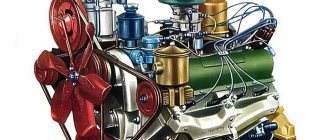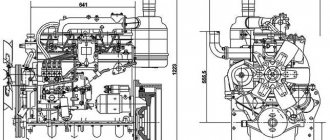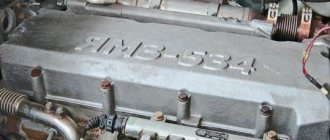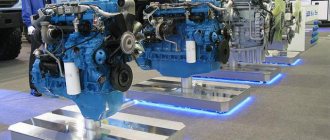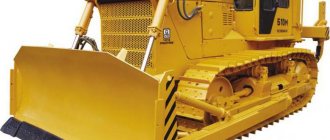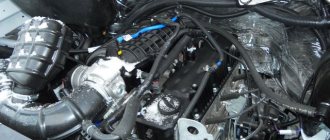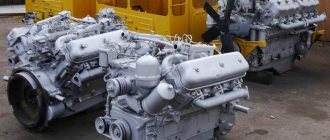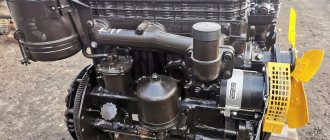Car history
The late 1950s and mid-1960s were management plans at the conveyor plant to produce three generations of trucks, which were unified among themselves. The base car was considered to be the new GAZ 52, which became the successor to the GAZ-51A truck, which also had a 4x2 wheel formula and a load capacity of 2,500 kilograms.
When creating the car, we tried to take into account that the main area of application of the truck would be urban transportation and operation in rural areas. Taking these points into account, the design features of the car should have ensured good maneuverability and fairly good cross-country ability along with a smooth ride, because asphalt roads were quite rare to find.
The creation of small and medium-tonnage trucks was necessary for the entire country, since it was undergoing a full-fledged process of restoring the national economy, which was destroyed during wartime, and also required the active construction of residential cities. There were simply very few cars that could operate in the city, and freight transportation as part of a road train did not develop either.
Therefore, the design staff was instructed to develop a project for a truck, which was initially intended for transporting various goods in the city and rural areas. There were versions of the GAZ 52 dump truck and on-board vehicle. Thus, a new model GAZ-52 was created on the GAZ 51 A platform, which had been produced since 1955.
A little later, the car was able to successfully replace the previous family. The new car stood out with a different cab, the design solution of which was somewhat similar to American trucks of the 1950s. In those years, many did not even imagine that this design would be in demand during all this time, and this is not much - no less - 30 years.
General information about the 52 model
GAZ 52 is a two-axle truck with a small load capacity. In the back of this dump truck model you can transport loads weighing no more than 2.5 tons. But this drawback did not prevent the car from occupying the position of leader in the automobile industry for several decades. It was this small truck that made up the lion’s share of the truck fleet in Russia and the former Soviet republics.
To this day, GAZ 52 trucks are often found in settlements where the road surface is not of high quality or there are no roads at all. Along with their low cost, trucks are valued for their reliability, good maneuverability and the ability to easily replace parts.
Appearance
The developed all-metal cabin for a small truck, which had a hood layout, was equipped with an improved windshield. Compared to the flat V-shaped windows that were installed on its predecessor, the new one provided the driver with panoramic visibility. The cabin was made for a couple of people.
The new cabin was supposed to be unified for all bonneted trucks of the Gorky Automobile Plant, and the external differences were only in a few elements. Moreover, not such a large number of people might know about them, because quite often the GAZ-53 car could be confused with which, by the way, most of the most important components of the car were unified, and the GAZ-52.
The debut cars of this family were quite similar to the previously produced ZILs - the sidelights were located at the bottom, and the headlights stood strictly above them. When 1975 came, the company's management decided to modernize the appearance of the cabin, which is why the sidelights moved upward, and the appearance of the radiator grille began to resemble a “smile”.
Nine years later, from 1984, the lining of the radiator grille of GAZ 52 trucks was further changed - its openings were slightly extended, and the turning lamps were moved to the sides. Having a similar appearance, the 52nd models were produced in a conveyor type until the 1990s, after which they were replaced by the restyled GAZ-3307.
Out of ignorance, you can quite easily confuse the GAZ-52 and GAZ-53 trucks, because they have a lot of similarities, especially in appearance.
Models of the debut years of production had only one single round mirror, located on the left, which was installed on a single bracket. This mount cannot be called reliable, since due to vibrations it became weak, the mirror began to shift and tremble while driving. A little later it was changed to an oval type, its dimensions increased.
The mirror was installed on a triple bracket, which reduced its vibration. They installed something similar on the right side, which increased visibility. The main colors for the cabs were sand and protective khaki. In the 1960s and 1970s, the color options were expanded to include aqua and café au lait.
1978 allowed the release of cars with a blue cabin color. The same year marked the presence of stamped stiffeners, by which most car enthusiasts could distinguish between the 52nd and 53rd cars.
The wheel rims for the pair of cars also differed - the tires for the 52nd model were narrow and had 6 ventilation holes, while the 53rd had 3 holes, and they were located at an angle of 120 degrees. However, despite the slight differences in appearance, the main difference between these cars was the power unit.
The lineup
Over the almost 40-year history of production, the GAZ-52 has acquired a huge number of modifications, among which a large number are experienced models that have not gone to the masses:
- GAZ-52F (failed experiment with a prechamber 85-horsepower engine with a load capacity of 2.5 tons);
- GAZ-52G (did not become mass-produced due to operational restrictions - the presence of only hard surfaces);
- GAZ-52A (base for special vans);
- GAZ-52P (tractor, experimental short wheelbase);
- GAZ-52Ya (variation with a short body).
However, the number of production models far exceeds the number of experimental ones:
- GAZ-52-01 (long-wheelbase version, used as a chassis for special equipment with a load limit of 2.5 tons);
- 52-02nd model (short wheelbase chassis for SAZ-3503, -3504 dump trucks);
- 52-03rd model (a classic flatbed truck with an extended wheelbase, it was replaced already in the 70s by the GAZ-52-04, the photo of which confirms the similarity);
- 52-04th model (flatbed modification with a shortened wheelbase, maximum load - 2.5 tons);
- GAZ-52-05 (a cargo taxi with a tilt-raised platform, structurally almost no different from the “52-04”);
- “52-06” (tractor, trailer weight limit – 6 tons);
- “52-07” (powered by liquefied gas, the cylinder is attached to the frame on the left);
- 52-09th model (modification of the 52-02nd model, “powered” by liquefied gas);
- “52-08” (compressed natural gas (CNG) is used for operation, duplicating A-76 gasoline);
- 52-27th version (base – “52-04”, powered by LNG);
- GAZ-52-28 (engine from “52-27”, but the cylinders are placed not on the frame, but behind the body).
Two export models were produced separately:
- 52-54 (area of operation – with a tropical climate);
- 52-74 (operating conditions – moderate climate).
In addition, a mobile repair workshop (MPR-99-24) and a ladder truck (AL-18) were produced on the 52-01 version chassis.
GAZ-52 is a real legend that still continues to ply Russian roads. In any case, the secondary market at a price of 40 thousand rubles offers a lot of options. And they have a chance to find a review for several reasons: the simplicity of the design, the simplicity and ability to save money on repairs and, of course, sufficient potential to perform the tasks that agriculture and municipal services pose for the truck.
The Gorky Automobile Plant was built in 1932 with the assistance of the American Ford Motor Company. The establishment of mass production began with the production of one and a half ton trucks and the 5-seater GAZ-A with a phaeton-type body. By 1981, the 10 millionth car had already rolled off the assembly line, and the 21st Volgas produced in the 60s, which have long become a rarity, can occasionally be seen on the roads to this day. What does the plant produce today, what tires and wheels can be installed on the Gazelle and other cars of this manufacturer? Read about this in our article.
Cabin interior
It is clear that the cabin was not large, but the most necessary things were there. On two doors the glass could be lowered and raised, and the windows could be turned. During movement, the air flow could be directed in any direction. Among the features of the cabin are the ability to blow hot air from the heater onto the front glass, as well as the ability to install vacuum windshield wipers driven by a special pump.
The instrument panel looked quite simple, but for those years it was quite functional and fulfilled its direct duties. The instrument panel had a fuel level indicator, coolant temperature, oil pressure, speed sensor and ammeter. There was also an ignition switch nearby.
Today, instrument panels have huge dimensions, but the GAZ-52 received a small, but quite informative one. A little to the side there was a place for the glove compartment. The turn switch lever has already been installed on the steering column, which is very convenient, especially considering that on the previous model the switch was placed on the dashboard, so it was still necessary to reach it, and this caused some difficulties, and the driver could be distracted from driving the truck.
However, the entire front panel was made of iron, which also applied to the door panels. There were no separate armchairs, only a full-fledged sofa was provided, the back and seat of which were raised, which provided the opportunity to store various spare parts, parts and tools.
Specifications
Power unit
The cars that were built between 1958 and 1959 were equipped with a prechamber-torch internal combustion engine. It is this power unit that is considered the advantage of the 51st model.
Back in 1937, specialists working at the Institute of Chemical Physics and the Central Institute of Aviation Engine Engineering began to develop and implement options for more productive combustion of gasoline in an internal combustion engine with an external mixture formation system, where there was a lean combustible mixture in the pre-chamber.
A little later, this work was already carried out on cars from the Gorky Automobile Plant. The engine platform of the 51st model made it possible to design the GAZ 52 engine, where the cylinder head was modernized and where there was an overhead valve arrangement. In addition, the cylinder head was equipped with a prechamber for each cylinder.
The gas distribution system had a chamber valve through which an air-combustible mixture was injected, which was lit by an ordinary candle. After this, the torch ignites the entire mixture in the main chamber. This technical process allowed saving up to 20% of fuel, as they believed then.
It also seemed that in this way it would be possible to significantly increase the power of the power unit along with torque. But, as tests showed, the GAZ 52 engine was difficult to start, it was also impossible to save fuel, and in general, the unit functioned unstably. Moreover, problems were created by the carburetor, which even at the enterprise itself, even competent specialists could hardly somehow regulate or configure.
However, such failures did not stop the specialists, and they still brought the power unit to the desired state. The result was a 3.4-liter 85-horsepower engine with a torque of 22.5 kg/m at 3,000 rpm. This GAZ 52 engine made it possible to significantly increase the dynamic component and make the car more economical.
GAZ-52 consumes about 24 liters per 100 kilometers. Years later, in the 1990s, car enthusiasts noticed trucks that ran on diesel fuel. Many drivers began installing brand new GAZ 52 diesel engines, which were notable for their low maintenance costs.
The GAZ-52 power unit turned out to be easy to repair and unpretentious to maintain, which cannot be said about many other cars.
Transmission
The new power unit has been synchronized with a reliable and quiet five-speed manual gearbox. It had synchromesh in 3rd and 4th gear. The clutch is single-disc and dry. Example photo below.
Suspension
They decided to install it as a spring type, and later it was subject to modernization. The design staff decided to change the method of fastening the springs - after the improvement, the fastening was carried out together with rubber cushions. As a result, it was possible to reduce the pressure on the main sheets while twisting the springs.
The front suspension was on longitudinal semi-elliptical springs along with hydraulic telescopic shock absorbers. The rear suspension had only longitudinal semi-elliptical springs with additional springs. A dependent suspension was installed both front and rear.
And in order to increase the cross-country ability of trucks on bad roads, the engineering staff developed and implemented the latest rear axles, which had a cam differential. This made it possible to more confidently pass difficult areas of the road.
Brake system
It has a hydraulic drive and a hydraulic vacuum booster. Only drum brakes are used on all wheels. There is a working and parking system.
Steering
The steering mechanism is of the globoid type. Globoid worm together with a double-ridge roller. There is no hydraulic power steering.
Diagnostic work
After disassembly, the degree of wear and the suitability of the parts for further use are determined. Each component of the GAZ-52 engine is measured. The procedure is carried out without fail; the group of pistons and the crankshaft are carefully measured. The motor is visually inspected for deformations, chips, cracks and other mechanical damage. Afterwards, displacers are selected based on measured dimensions and weight. In this process, the main thing is to select pistons based on the repair size (82.5-83mm). If the values go beyond a larger value, there is no point in boring the core, since only installing sleeves will help in the situation.
Advantages and disadvantages
Pros of the car
- Good maneuverability;
- Good ride height;
- No problems with purchasing spare parts and components;
- Good maintainability;
- Low price of a truck;
- Small dimensions;
- Designed for rural areas;
- Unpretentious car;
- Clear controls;
- Soft sofa;
- Not a loud gearbox.
Cons of the car
- Outdated cabin design;
- There is not enough free space in the cabin;
- Low load capacity;
- Weak power unit;
- High fuel consumption;
- Oldest year of production;
- No hydraulic power steering;
- The hood interferes with good visibility.
Characteristics of the GAZ 5312 truck
Brand nameAbarthACAcuraAlfa RomeoAROAsiaAston MartinAstraAudiBAWBeifang BenchiBeijingBentleyBMWBrillianceBugattiBuickBYDCadillacChanaChanganChangFengChangheCheryChevroletChryslerCitroenDaciaDadiDaewooDAFDaihatsuDatsunDerwaysDodgeDong FengEagleFAWFerrariFiatFordFotonFreightlin erGeelyGMCGreat WallGrozHafeiHaimaHaniaHINOHoldenHondaHOWOHuachenHummerHyundaiInfinitiInternationalIntrallIran KhodroIsuzuIvecoJACJaguarJCBJeepKenworthKiaLADALamborghiniLanciaLand RoverLDVLexusLifanLincolnLotusLuxgenMACKMANMaseratiMazdaMercedes-BenzMercuryMGM iniMitsubishiMorganNissanOldsmobileOpelOtokarPeterbiltPeugeotPlymouthPontiacPorscheProtonRange RoverRavonRenaultRolls-RoyceRoverSaabSamsungSaturnScaniaScionSeatSetraShaanxiShacmanSkodaSMASmartSpykerSsangYongSubaruSuzukiTataTatraTeslaToyotaTVRVauxhallVolkswagenVol voVortexWartburgWestern StarWiesmannXinKaiYUEJINZhonghuaZhongxingZotyeZukBusAuto catalogCar partsCar stickersAZLK (Moskvich)Promotional offersAtlases and mapsBAZBelazBogdanVAZ (Lada)VISGAZGas equipmentTrucksEnginesDoninvestZAZZILIZHKAvZka MAZCarburetorsMaps and AtlasesATVsCombine-harvestersKRAZBody repairLIAZLiterature for driving schoolsLiterature for STOBOAT motorsLUAZMAZMopedsMotorboatsMotor scootersMotorcyclesPAZPostersRoad rulesMiscellaneousSale RAFAgricultural machineryScootersStreet racingTagazTests on traffic rulesTractorsTuningUAZURALTraining literatureExam papersElectrical equipmentCar encyclopediaLegal assistanceModel name Show
Characteristics of the GAZ 5312 truck
| GAZ 5312 (1961-1992) | |||||||||||||
| Body | |||||||||||||
| Truck | |||||||||||||
| |||||||||||||
| Engine | |||||||||||||
| 4.25 | |||||||||||||
| Engine's type: | Diesel, V8, 16-valve | ||||||||||||
| Gas distribution system: | OHV | ||||||||||||
| Supply system: | Carburetor | ||||||||||||
| Power, hp/at rpm: | 120 / 3200 | ||||||||||||
| Torque, N•m / rpm: | 190 / 4500 | ||||||||||||
| Transmission: | MCP |
| Number of gears: | 5 |
| Rear: | Spring |
| Power steering: | — |
| Rear: | Drums |
| Systems: | — |
| Acceleration time to 100 km/h, sec.: | — |
| Tire size: | 8.25 R20 |
| Fuel tank volume, l: | 100 |
| Fuel type: | Gasoline A-76 |
| Fuel consumption (in the city), l. per 100 km: | 17.0 |
| Fuel consumption (outside the city), l. per 100 km: | — |
autoinform96.com
Let's sum it up
Despite the fact that the GAZ 52 car was made for the twentieth century, it is still often used in various industries today. Yes, the level of comfort may not be at a high level, and there are no new technical bells and whistles, but the car copes well with its direct responsibilities.
It has small overall dimensions, which allow it to function even in urban conditions as transport for housing and communal services or in agriculture. Moreover, the latter reveals all its good qualities, because it is not afraid of bad roads and has a good ground clearance, which is very important.
The conditions inside the cabin are not ideal, but do not forget in what years this truck was created and for what purposes - the country was being built, and it was important to improve agriculture. The GAZ-52 is perfect for work, since it can be repaired without any difficulties, the mechanisms are quite simple, and parts and spare parts can be found in almost any automobile market.
We advise you to read the article: GAZ - the history of car production
Motor repair
Since the GAZ 52 power plant is no longer produced, most of the products used need to be repaired. The advantage of the unit is that the device is restored on its own; of course, for some operations you will have to turn to knowledgeable people. The overhaul procedure for the device is identical to the procedure carried out for most six-chamber in-line engines. If you analyze the financial part of the issue, the cost of restoration is not small and this is another reason to make the engine yourself.
First, the traction unit is removed from the machine and disassembled. To do this, auxiliary mechanisms, the head, are removed from the engine, pistons and shafts are removed.
Motor disassembly:
GAZ-52 photo
Read further:
GAZ-63
Jaguar XK120
KrAZ-256
BMW X6 Alligator is the ugliest car at the Frankfurt motor show
Mercedes-Benz 300SL
KamAZ-4308


